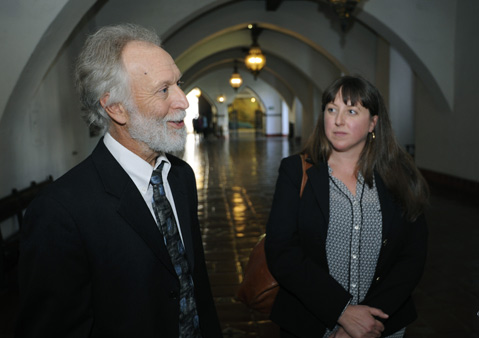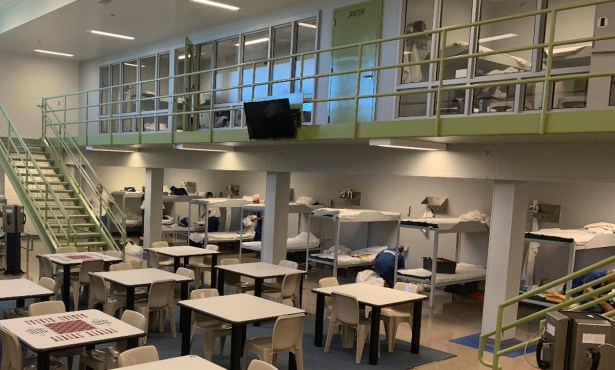Judge Blasts Analysis of Freeway-Widening Project
Said Caltrans Report Failed to Address Traffic Impacts on City Streets

Intense, wiry, and conspicuously devoid of any facial hair, Judge Thomas Anderle can in no way be mistaken for Santa Claus, but for critics of Caltrans’s proposal to widen Highway 101 from Santa Barbara to Carpinteria, Anderle’s ruling this week qualified as an early Christmas present.
In a strongly worded, 76-page decision, Anderle found the environmental analysis conducted by Caltrans to be “legally flawed” and “defective,” ruling that the report “utterly failed” to address the increased congestion the freeway-widening project will generate for nine Santa Barbara intersections — 15 when looking at the cumulative impacts.
Anderle concluded “there is no evidence” Caltrans ever considered the actual impacts to the intersections in question but, even so, that the state highway-building agency consistently concluded “the overall benefits” of the project far outweighed any potential problems. “It was an abdication of Caltrans’ responsibility,” Anderle concluded, “to consider and resolve every fair argument that can be made about the possible significant environmental effects of the project.”
Absent an appeal by Caltrans or its local partner in the $425 million freeway-widening effort, the Santa Barbara County Association of Governments (SBCAG), Anderle’s ruling means a portion of the environmental document must be reexamined and recalculated. Anderle emphasized he was not ordering Caltrans to find these impacts environmentally “significant” — a legally crucial distinction — only that the agency justify any finding it made with evidence and analysis. How long this will take and how much it delays the freeway-widening effort remains very much an open question.
The widening project has been the focus of intense political and economic heat throughout the South Coast for close to 20 years. In some ways, the feud between former allies Santa Barbara Mayor Helene Schneider and County Supervisor Salud Carbajal — who share not just the same birthday, November 18, but the same ambition to replace Lois Capps in Congress — is rooted in unresolved differences over the negative consequences of the freeway widening and efforts to mitigate those impacts. Schneider and City Hall have long objected that Caltrans’s environmental analysis failed to consider the additional congestion the freeway widening would cause by allowing so many more commuters on the road from Ventura and other points south to the South Coast. “My initial review of Judge Anderle’s tentative ruling reflects what I believe our residents want: a good project that will reduce traffic congestion during commute times from the county line to their workplace,” said Schneider.
“We need to continue to do everything we can to move forward with the planned widening of Highway 101 in a timely way. The voters overwhelming supported funding this vitally needed project,” said Carbajal.
When Caltrans certified the environmental impact report (EIR) in August 2013, the City Council balked at filing a legal challenge. Instead, a paper environmental group with only a handful of members — the Transportation Futures Committee — lodged a complaint. Attorney Marc Chytilo, a specialist in environmental law with an enviable track record of success in Judge Anderle’s courtroom, has led the legal charge since.
Under state law, the environmental impacts of any project must be mitigated or avoided if they are deemed to be “significant.” If they can’t be feasibly mitigated, decision makers are allowed to make “findings of overriding consideration,” but only after acknowledging the negative impacts and decreeing that they are outweighed by the benefits. Chytilo argued that the additional traffic generated from the south by the freeway widening would back up around Salinas Street and create a jam all the way to Goleta.
This, in turn, would prompt commuters to take to city streets in greater numbers, seeking relief from freeway congestion. This doomsday scenario has been embraced by transportation planners at City Hall and is based on a report conducted by the same engineers who worked on the freeway-widening traffic analysis. Caltrans engineers and attorneys have insisted that in the context of the whole 11-mile widening project — relieving thousands of commuters the agonies of gridlock, also with the addition of a carpool lane — the additional congestion at these intersections is negligible.
On Tuesday, Caltrans attorney Derek Van Hoften sought to change Anderle’s mind, pointing out that of 104 intersections Caltrans analyzed, only nine were projected to experience increased congestion. And in those cases, he stressed, the burden would only be a few seconds more. Anderle declined to budge, stating he well understood the enormity of the case. “I’d hate to tell you how much time I put in on it,” he said, washing his large hands over his bald head.
Chytilo and his Transportation Futures Committee had also asked Anderle to require additional analysis for the impact of additional traffic on the freeway itself — not just the intersections — but the judge refused, explaining that because the issue was not raised during the public-comment period on the environmental documents, Chytilo had failed to exhaust all legislative remedies before pursuing litigation.



